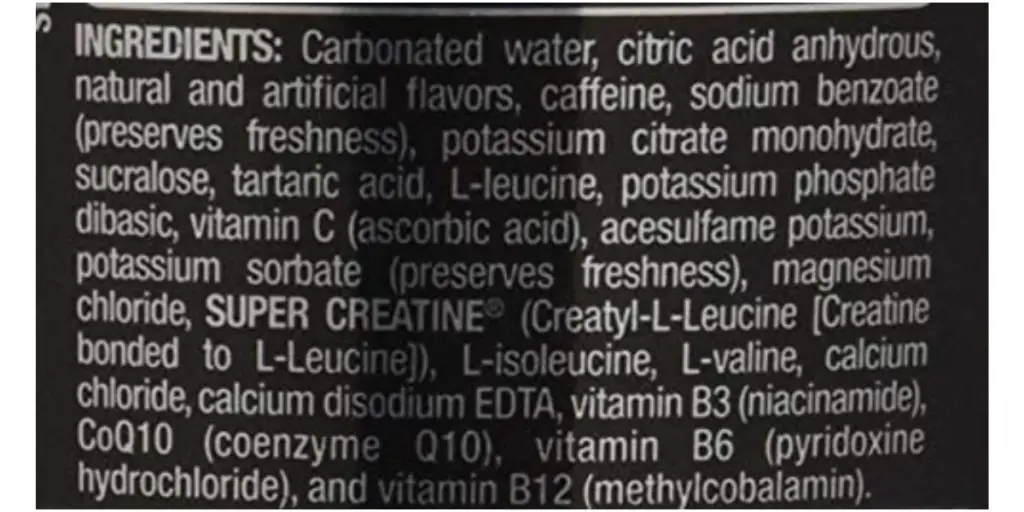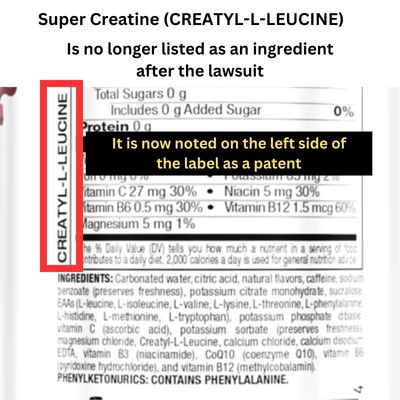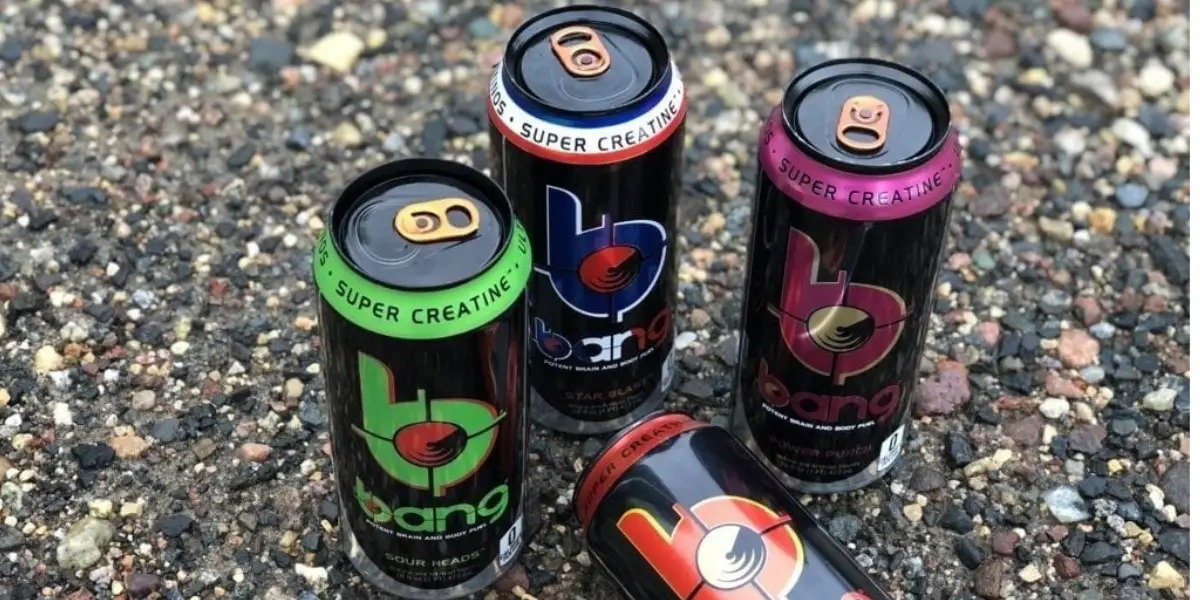How Much Creatine Does Bang Energy Contain?
There’s no denying the appeal of a Bang Energy drink eye-catching can, radiating vitality with its vibrant colors and sleek design.
They’ve swiftly become popular among fitness fanatics and those seeking mental focus and a quick energy lift.
One unique selling point that touts to lure customers is its so-called “Super Creatine.” But what’s the real scoop about the actual creatine content?
If you’ve been dreaming of supercharging your muscles with a substantial creatine boost via Bang Energy, brace yourself for a reality check.
Contrary to their marketing hype, Bang does not contain creatine, the substance famed for its muscle-building magic. Instead, Bang Energy drinks contain a proprietary compound called creatyl-l-leucine, fancily labeled as ‘Super Creatine.’ It is not a substitute for natural creatine nor does it share any of the benefits.
Let’s dive headfirst into the nitty-gritty of Bang, exploring their ingredients and focusing mainly on the much-vaunted Super Creatine.
By the end of this article, you’ll have a crystal-clear picture of what you’re ingesting with each pop of a can, empowering you to decide whether it is the drink you’ve been searching for.
Decoding Bang: What Set’s Them Apart?
Amidst the bustling energy drink market, they’ve successfully carved a niche for itself. The eye-catching cans and diverse palette of flavors, from Star Blast to Miami Cola, cater to a broad spectrum of taste preferences.
However, the real distinguishing factor for Bang Energy Drinks lies in their unique concoction of ingredients designed to appeal to health-conscious consumers.
The Over-Hyped Bang Energy Ingredient
Have you ever paused mid-sip to wonder what’s dissolved in your can of Bang? Let’s dissect the core ingredients present in Bang, examining their potential advantages and disadvantages.
A Bang Energy drink’s creatine content (or lack thereof) is a huge source of confusion. As a fitness enthusiast, the idea of an energy drink packed with creatine, a compound well known to boost physical performance, could be exhilarating.
However, let’s rip off the band-aid: How much creatine does one have? They have absolutely zero. None, zip, nada. Not one bit. Instead, they contain Super Creatine, or creatyl-l-leucine, which no reliable source acknowledges as creatine or sharing any of the same benefits (unfortunate, but true).
We’ll get into this later, but for now, remember that Bang’s scoreboard reads a stark zero when it comes to creatine content.
Unraveling the Super Creatine Myth
The National Library of Medicine attests that Super Creatine isn’t creatine in any shape or form and doesn’t deliver the perks associated with it, such as improved physical performance or muscle growth.
The So-Called Benefits of ‘Super Creatine’?
Bang Energy has pitched its Super Creatine as a turbocharged version of standard creatine. They’ve claimed it to be “20 times more effective at reaching the brain than other forms of creatine and even hinted that it could alleviate conditions like Alzheimer’s and Parkinson’s.
However, these claims are at odds with scientific studies that demonstrate creatyl-l-leucine is not a bioavailable source of creatine and doesn’t accumulate in muscle, brain, or plasma or do much of anything.
Boiled down to its essence, Super Creatine is nothing more than a marketing gimmick, and consuming it won’t enhance your strength, speed, or overall performance.
What’s The Difference Between ‘Super Creatine’ and Creatine Monohydrate
The ingredient Super Creatine found in Bang Energy drinks, which includes L-Leucine, is claimed to enhance focus and mental clarity.
Meanwhile, creatine monohydrate, a naturally occurring compound, is renowned for its ability to help build muscle mass.
Understanding the distinction between Super Creatine and creatine monohydrate is crucial for consumers due to their health advantages.
Often, individuals buy Bang Energy drinks, assuming they will reap the rewards of creatine. Sadly this is not the case.
Mayo Clinic notes Creatine Benefits:
- Boosted athletic performance: Research indicates that it can enhance the performance of athletes in activities demanding quick energy bursts, such as sprinting.
- More strength and lean muscle mass: It can stimulate muscle growth, making it a sought-after supplement among bodybuilders and weightlifters.
- Potential neuroprotective properties: Initial research suggests it may aid in combating neuro-muscular diseases like Alzheimer’s and Parkinson’s.
So, while Bang may deliver a caffeine kick, it won’t provide the benefits of actual creatine found in other supplements.
Are Bang Energy Drinks Healthy?
Traversing the health landscape of energy drinks can be perplexing. Remember, while a Bang Energy drink might offer the energy boost you need, it should be consumed in moderation. As with everything in your diet, balance is paramount.
One Bang Energy drink has a hefty caffeine load, about 300mg per can. Excessive consumption of this high caffeine content can induce numerous side effects.
Going overboard can leave you feeling subpar, from sleeplessness and anxiety to restlessness and headaches. More severe side effects could involve an elevated heart rate, hypertension, and digestive issues.
The Bang Energy Drink Ingredients Label
Bang Energy’s lack of transparency about the quantities of its ingredients is evident in its nutrition label. There’s no explicit disclosure of the amount of each ingredient present in their energy drinks contained here.
They need to make it easier for consumers to evaluate the drink’s efficacy beyond the energy from its caffeine content.
Their old nutritional label used to list Super Creatine as an ingredient. But after they lost the lawsuit, they removed it. It’s still mentioned on the can, but it’s now written on the left side of the label.
Here, in the old nutrition label, you can see that SUPER CREATINE is listed (before the lawsuit) proudly and boldly as an ingredient.

Here, on the new label, Super Creatine is no longer listed in the ingredients. Instead, it’s now written to the side as CREATYL-L-LEUCINE

If there is anything notable to mention is that Bang has zero carbohydrates, zero calories, and zero sugar. And plenty of caffeine if you need a kick.
Caffeine Content in Bang
A glance at the amount of caffeine content in Bang Energy Drinks reinforces why moderation is key. Averaging 300mg of caffeine per can, Bang Energy has a significant edge over many rivals in the energy drink sector.
To put this into perspective, consider that most health authorities, including WebMD and Mayo Clinic, suggest that adults can safely consume around 400 milligrams of caffeine daily.
This equates to roughly four to five standard-sized cups of coffee.
If you’re drinking more than one Bang Energy drink daily, you might exceed the recommended daily caffeine intake.
It’s important to remember that the caffeine content in beverages can vary significantly, particularly among energy drinks. Therefore, always monitor your daily consumption.
How does the caffeine content in Bang Energy compare to other popular beverages?
Caffeine in a single Bang Energy Drink vs. Popular Energy Drinks
| Energy Drink | Caffeine Per Serving In (mg) |
| Bang Energy | 300 mg |
| Coffee (8 ounces) | 95 mg |
| Red Bull | 80 mg |
| Monster Energy | 160 mg |
| Celsius | 200 mg |
| Jocko Go Pre-workout | 95 mg |
As you can see, Bang Energy surpasses many popular choices in terms of caffeine content. This high level of caffeine can be both a blessing and a curse.
It offers a substantial energy surge but, if consumed excessively, can result in the previously discussed side effects.
The key, as always, is moderation and comprehension of your body’s reaction to too much caffeine.
The Mayo Clinic states that the effectiveness of creatine in enhancing athletic performance can be diminished when combined with caffeine.
Therefore, its impact would likely be negligible even if Bang contained creatine monohydrate.
Amino Acides (BCAA) in Bang Drinks
Alongside caffeine, Bang Energy Drinks also incorporate Branched-Chain Amino Acids (BCAAs). These crucial nutrients, including leucine, isoleucine, and valine, are highly regarded for their potential role in muscle development and recovery.
Athletes and fitness enthusiasts frequently use amino acids to manage exercise-induced fatigue and boost overall athletic performance.
However, a minor snag emerges when you scrutinize the nutrition label on the can.
Despite the brand’s proud declaration of essential amino acids in their formula, they don’t clarify how much of each is present in a single can.
This omission complicates matters for consumers trying to determine these energy drinks’ potential benefits.
The Amino Acids in Bang
- Leucine: Supports muscle protein synthesis and muscle growth
- Isoleucine: Boosts glucose utilization and muscle tissue repair
- Valine: Supports energy production and muscle metabolism
Remember that while these benefits are generally recognized, the effectiveness of essential amino acids in Bang is unknown.
And, if you’re counting on the BCAAs in Bang to blow up your muscle cells to pack on lean mass, the ambiguity of the actual content might leave you disappointed.
Potential Health Risks of Bang Energy
While Bang Energy might offer a potent caffeine boost, they also carry potential adverse effects. Overconsumption of caffeine can lead to insomnia, anxiety, jitters, headaches, elevated heart rate, hypertension, and digestive problems.
Enjoying this sort of drink in moderation and respecting the recommended daily caffeine intake limits is always advisable.
And understanding the composition of your energy drink is as vital as the impact it has on you. In the following sections, we’ll jump into some controversy surrounding Super Creatine.
Bang Energy Lawsuit – Super Creatine Marketing Gimmick
The advertising around Bang Super Creatine has yet to be without legal consequences. Monster Energy Co., another significant entity in the energy drink market, secured a $293 million verdict against Bang Energy for false advertising and trade secrets violations.
The lawsuit primarily focused on Super Creatine branding, with the jury agreeing with Monster’s claims that Bang misled customers about the benefits of its ‘Super Creatine,’ which, as we now know, lacks any creatine.
This verdict is one of the most substantial in the annals of false advertising cases. If Bang Energy is proven to have intentionally violated Monster’s rights, the damages could potentially triple, resulting in a further financial setback.
In simple terms, it’s crucial to approach marketing claims with skepticism, especially when it involves our health and performance. As always, conducting thorough research and making informed decisions is vital. Keep this in mind as we continue to explore the world of Bang Energy Drinks.
Bang Energy Alternatives
Several other options are available if you’re seeking alternatives to Bang Energy. Some popular choices include:
- Monster: Offers a high-caffeine option but with slightly lesser levels than Bang.
- Celsius: Provides a distinctive blend of green tea extract and other thermogenic ingredients.
- Reize: A powdered energy drink allows you to adjust the strength as you prefer.
- Coffee: The traditional caffeine source with various flavors and preparation methods.
- Jocko Go Pre-workout: Includes many beneficial ingredients to enhance your workout, featuring BCAAs.
Bang and the Absence of Creatine Wrap-up
Bang Energy Drinks have established a distinctive place in the energy drink market, characterized by its high caffeine content and appealing variety of flavors.
However, the reality about their ‘Super Creatine’ ingredient differs substantially from their marketing representations.
Contrary to the insinuations, the amount of creatine in Bang Energy is zero.
Key Takeaways:
- Despite the Bang ‘Super Creatine’ branding, the drinks don’t contain real creatine. Their proprietary ingredient, creatyl-l-leucine, doesn’t serve as a bioavailable source of creatine.
- The high caffeine content in Bang Energy Drinks can lead to potential health complications if over-consumed. Hence, it’s advisable to consume these drinks in moderation.
- Bang Energy’s lack of transparency concerning the amounts of ingredients in its drinks makes it difficult for consumers to assess the drink’s effectiveness beyond the energy derived from caffeine. This aspect is critical to consider when deciding whether these drinks meet your specific needs.
Frequently Asked Questions (FAQs)
What is the amount of creatine in bang?
Bang energy drinks do not include creatine. They utilize a proprietary blend called ‘Super Creatine,’ which is essentially creatyl-l-leucine.
What does the ‘Super Creatine’ in Bang do?
Despite its title, it is not an amino acid of any sort. It doesn’t provide the benefits associated with actual creatine monohydrate. It doesn’t enhance athletic performance, improve stamina, or promote muscle growth.
Is creatyl-l-leucine safe?
Generally, Bang is deemed safe for most individuals when enjoyed in moderation. However, their Super Creatine doesn’t offer the benefits typical of traditional creatine supplements.
Does it help build muscle?
Contrary to misleading advertising, ‘Super Creatine’ doesn’t support muscle development. It’s not a bioavailable source, known to stimulate muscle growth.
What does it do to your body?
‘Super Creatine’ doesn’t confer any known benefits to the body. It doesn’t enhance athletic performance, improve stamina, or stimulate muscle growth like real creatine.
What’s the difference between ‘Super Creatine’ and creatine?
Super Creatine is a proprietary blend of creatine bonded to leucine (an amino acid). The idea is to have something that is water-stable and easily consumed. In contrast, creatine is a naturally occurring substance found in meat and fish, and the body can produce it.
How much super creatine should I take?
There’s no suggested dosage for Super Creatine.
Sources and Citations
WebMD. (n.d.). BCAAs: Health benefits, uses, safety information, dosage, and more. WebMD. https://www.webmd.com/diet/health-benefits-bcaas
da Silva, R. P. (2022, February 8). The dietary supplement creatyl-L-leucine does not bioaccumulate in muscle, brain, or plasma and is not a significant bioavailable source of creatine. Nutrients. https://www.ncbi.nlm.nih.gov/pmc/articles/PMC8840086/
Mayo Foundation for Medical Education and Research. (2023, May 11). Creatine. Mayo Clinic. https://www.mayoclinic.org/drugs-supplements-creatine/art-20347591.
- 5 Best Power Towers For Your Home Gym - July 19, 2023
- What Does Natty Mean in Body Building? Is It Good or Bad? - June 26, 2023
- How Much Creatine Is In Bang? The Amount Might Surprise You - June 25, 2023

